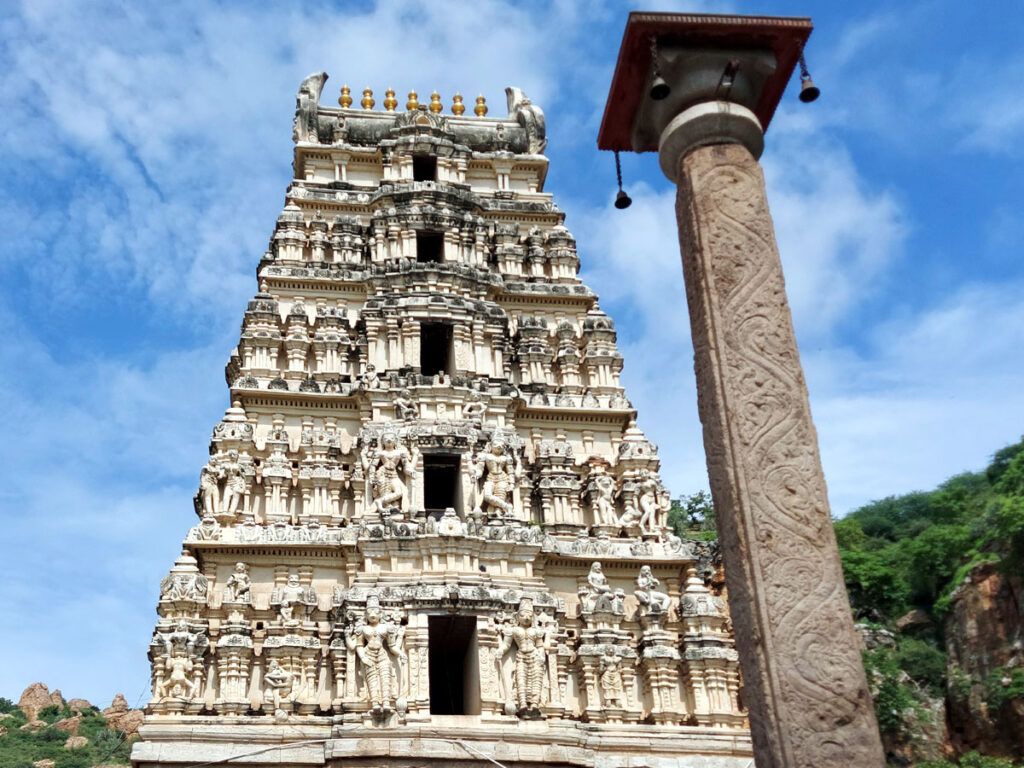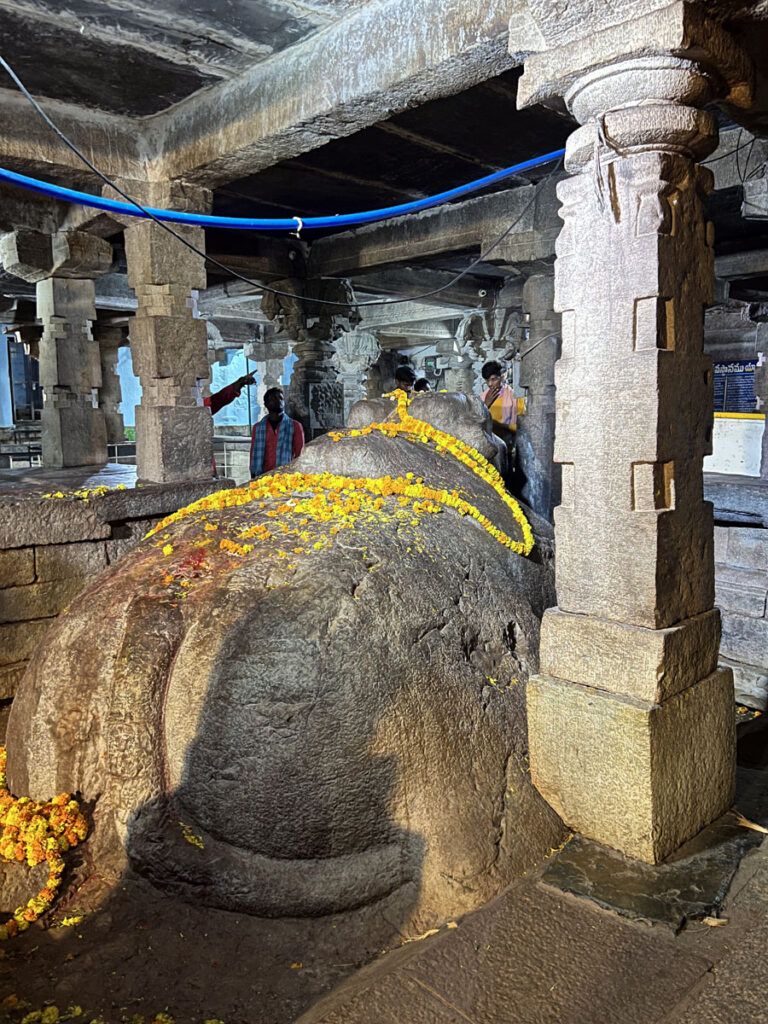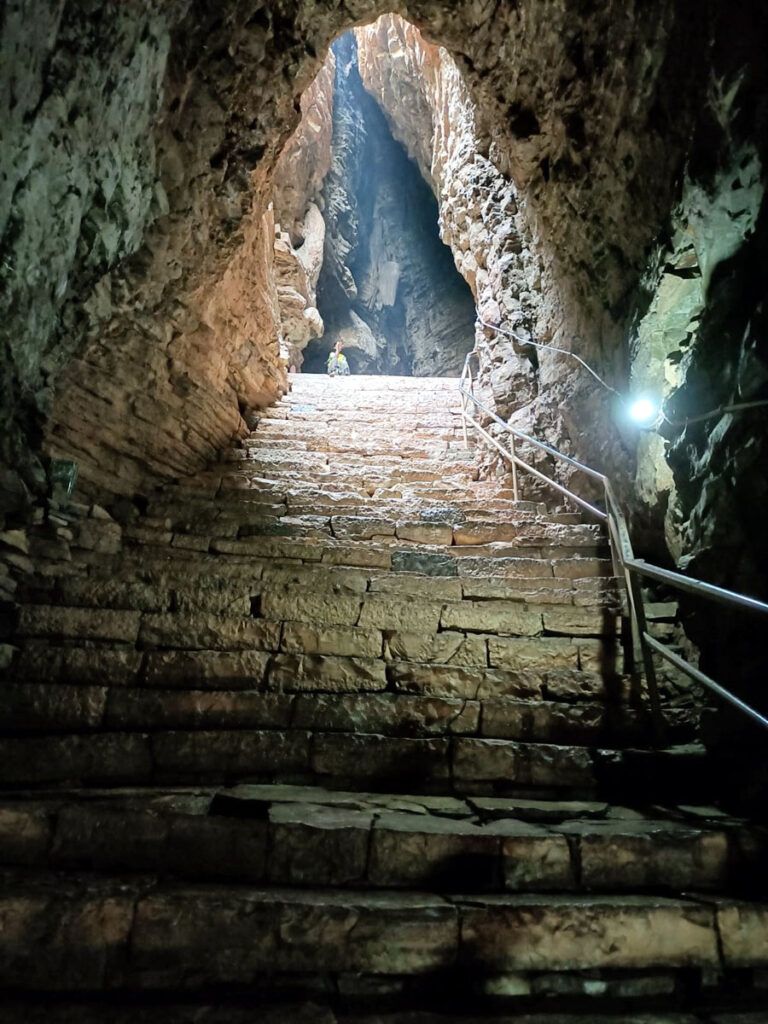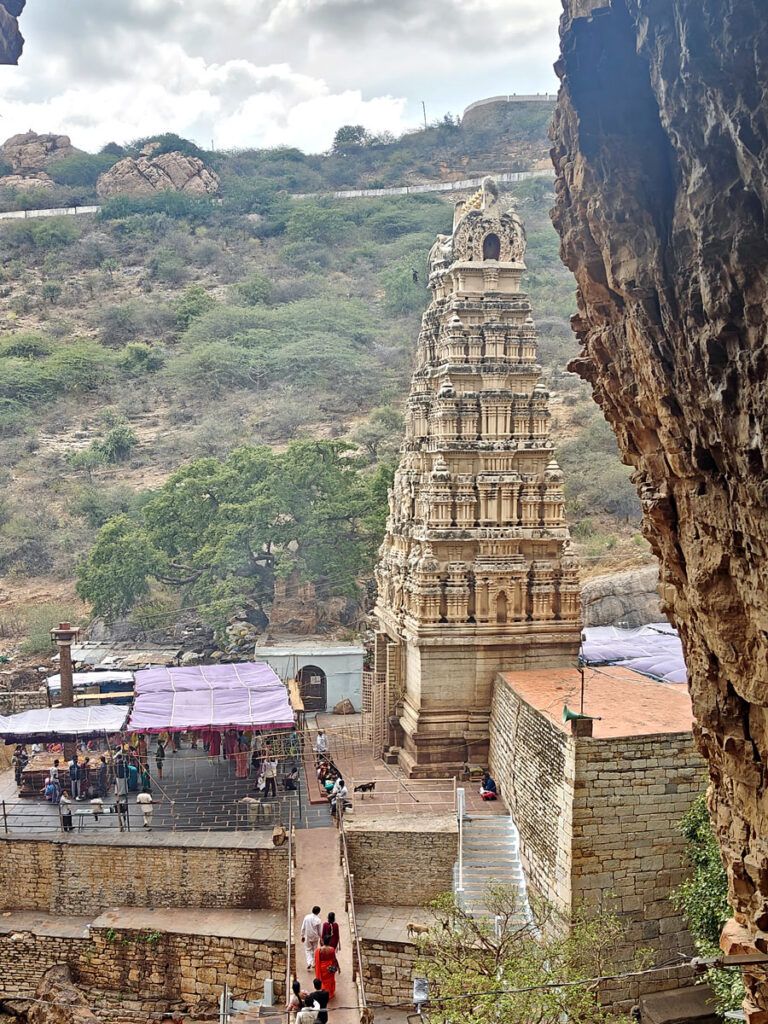5th CE Yaganti Temple with Mysteries
Yaganti Temple, officially known as Sri Yaganti Uma Maheswara Temple, is a famous Hindu temple dedicated to Lord Shiva. It is located in the Yaganti village of Kurnool district in the Indian state of Andhra Pradesh. The temple is renowned for its unique idol of Nandi, the sacred bull and mount of Lord Shiva, which is continuously growing in size.

Contents
- 1 History of Yaganti Temple:
- 2 Legend of Yaganti Temple:
- 3 Significance of Sri Yaganti Uma Maheswara Temple:
- 4 Yaganti Temple Timing and Rituals:
- 5 Festivals at Sri Yaganti Uma Maheswara Temple:
- 6 Mystery of the Growing Nandi at Yaganti Temple:
- 7 Places to visit near Yaganti Temple:
- 8 FAQ:
- 8.0.1 1. Where is Yaganti Temple located?
- 8.0.2 2. When was Yaganti Temple built?
- 8.0.3 3. Who are the main deities worshipped at Yaganti Temple?
- 8.0.4 4. What are some of the unique features of Yaganti Temple?
- 8.0.5 5. What are the timings for visiting Yaganti Temple?
- 8.0.6 6. What are the facilities available at Yaganti Temple?
- 8.0.7 7. What is the best time to visit Yaganti Temple?
- 8.0.8 8. What are some of the things to do near Yaganti Temple?
- 8.0.9 9. How do I get to Yaganti Temple?
- 8.0.10 10. What are some of the things to keep in mind while visiting Yaganti Temple?
- 9 Yaganti Temple Accommodation:
- 10 How to reach Yaganti Temple:
- 11 Google Maps:
History of Yaganti Temple:
Origins of the Temple:
While the exact date of the temple’s construction remains shrouded in mystery, historians believe it was built around the 5th-6th centuries. Various dynasties, including the Cholas, Pallavas, Chalukyas, and Vijayanagara rulers, are credited with contributing to its development and grandeur.
An intriguing legend:
One captivating legend surrounding the temple’s origin involves the sage Agastya. It’s said that he desired to build a temple for Lord Venkateswara on this very spot. However, the divine deity instructed him to first install an idol of Lord Shiva, as he was the “lord of this place.” Thus, the temple came to be dedicated to both Lord Shiva and Lord Venkateswara.
The Vijayanagara Empire’s Touch:
The temple received significant additions and renovations during the reign of Harihara Bukka Raya, the founder of the Vijayanagara Empire, in the 15th century. The Vijayanagara style is evident in several architectural elements, including the intricately carved pillars, gopurams (entrance towers), and mandapas (halls).
Unique Features and Mysteries:
The Yaganti temple is renowned for its unique features, some of which defy explanation. One such mystery is the phenomenon of water flowing uphill. A natural spring within the temple complex flows upwards, defying the laws of gravity. This phenomenon has attracted pilgrims and scientists alike, leaving many in awe.
Another enigma is the “growing Nandi.” This massive stone Nandi (bull), the vehicle of Lord Shiva, is believed to be growing in size over the centuries. While scientific evidence is yet to confirm this claim, it adds to the temple’s mystique and allure.
Read More>> Kanipakam Varasiddhi Vinayaka Swamy

Legend of Yaganti Temple:
The Broken Toenail and the Divine Intervention:
The first legend tells the tale of Sage Agastya, a revered figure in Hindu mythology. Seeking to build a temple for Lord Venkateswara, he commissioned a magnificent idol. However, upon its completion, Agastya discovered a devastating flaw – the toenail of the idol was broken.
Distraught and filled with despair, Agastya embarked on a rigorous penance, seeking solace and guidance from Lord Shiva. Shiva, moved by the sage’s devotion, appeared before him and declared, “This place, with its resemblance to Mount Kailash, is more suited for a Shiva temple.”
Upon Agastya’s request, Shiva bestowed upon him a unique gift – a single stone idol depicting the divine union of Shiva and Parvati, known as Uma Maheshwara. This sacred idol became the focal point of the Yaganti temple, forever enshrining the divine intervention that shaped its destiny.
The Curse of the Crows and the Absence of Shani:
Another legend speaks of a time when Sage Agastya was interrupted in his meditations by the incessant cawing of crows. Incensed by their disruption, he uttered a curse: “May no crow ever set foot on this sacred ground.”
This curse, it is believed, not only banished crows but also extended to their lord, Shani Dev, the god of Saturn and justice. As a result, the Yaganti temple is considered a sanctuary, free from the influence of Shani and offering respite to those seeking spiritual solace.
The Mystery of the Uphill Stream:
Adding to the mystique of Yaganti is the unique phenomenon of its temple pond. Mysteriously, water flows uphill from the base of the hill through the mouth of a Nandi statue, filling the pond throughout the year. This seemingly impossible feat adds to the temple’s aura of wonder and reinforces its association with divine power.
The legends of Yaganti temple are not mere stories; they are testaments to the enduring power of faith and the divine forces that shape our world. Whether seeking spiritual solace, marveling at the mysteries of nature, or simply appreciating the beauty of ancient architecture, Yaganti offers a unique and unforgettable experience for all who visit.
Read More>> Tirumala Tirupati Venkateswara Swamy

Significance of Sri Yaganti Uma Maheswara Temple:
1. Unique Worship of Lord Shiva: Unlike most Shiva temples, Yaganti houses an idol of Lord Shiva with Goddess Parvati, known as Uma Maheshwari, instead of the traditional Shiva Linga. This rare representation symbolizes the harmonious union of masculine and feminine energy.
2. The Mystery of the Growing Nandi: Within the temple complex lies a fascinating peculiarity – a stone Nandi (bull), the loyal companion of Lord Shiva, believed to be growing by an inch every 20 years. This phenomenon, though unexplained, adds to the temple’s mystical aura.
3. The Legend of Sage Agastya: The temple’s origin is intertwined with the legend of Sage Agastya. He initially intended to install a Venkateswara idol here, but due to unforeseen circumstances, Shiva himself revealed this site to be more suited for a Shaivite temple. Thus, Yaganti became a revered place for Shiva devotees.
4. The Miraculous Agastya Pushkarini: The temple boasts a unique feature – the Agastya Pushkarini, a sacred pond where water mysteriously flows from the mouth of a Nandi statue located at the base of the hill. The year-round presence of this freshwater spring adds to the temple’s mystique.
5. A Haven for Diverse Faiths: Yaganti transcends religious boundaries, attracting devotees of various faiths. The temple complex houses shrines dedicated to Lord Venkateswara, Goddess Durga, and other deities, offering a space for individuals of different backgrounds to find spiritual solace.
6. A Blend of Architectural Styles: The temple showcases a fascinating blend of architectural styles, reflecting the contributions of dynasties like the Pallavas, Cholas, Chalukyas, and Vijayanagara rulers. This intriguing mix results in a unique and captivating visual experience.
7. The Enchanting Caves of Yaganti: Beyond the main temple, the surrounding hills hold a treasure trove of ancient caves with intricate carvings and inscriptions. These caves offer a glimpse into the region’s rich history and add to the mystical atmosphere of the place.
8. A Cultural Hub: The temple is not just a religious site, but also a vibrant cultural hub. Throughout the year, it hosts various festivals and events, showcasing traditional dance forms, music performances, and local art exhibitions, providing a window into the region’s rich cultural heritage.
9. A Natural Retreat: Located amidst the verdant Nallamala Hills, the Yaganti Temple offers a refreshing escape from the hustle and bustle of city life. The serene surroundings, coupled with the temple’s spiritual aura, create a perfect environment for introspection and rejuvenation.
10. A Site of Historical Importance: The temple’s history dates back to the 5th and 6th centuries, making it a significant historical landmark. The presence of inscriptions and carvings within the temple complex offers valuable insights into the region’s past and contributes to its historical significance.
Read More>> Kedarnath Temple: Where Faith Meets Jyotirling & Char Dham Yatra

Yaganti Temple Timing and Rituals:
Temple Timings:
- Darshan (viewing the deity): 6:00 AM to 1:00 PM and 3:00 PM to 8:00 PM
- Poojas (rituals): Performed within the darshan timings
Here’s a breakdown of the daily rituals:
Morning:
- Suprabhatham: 6:00 AM – Waking up the deities with devotional songs and chants
- Abhishekam: 7:00 AM – Bathing the deities with milk, ghee, curd, honey, and other sacred offerings
- Alankaram: 8:00 AM – Decorating the deities with flowers and ornaments
- Mangalarathi: 8:30 AM – Offering lamps to the deities
- Nivedhana: 9:00 AM – Offering food to the deities
- Archana: 9:30 AM – Chanting hymns and prayers in praise of the deities
Evening:
- Sandhya Arati: 6:00 PM – Evening lamp offering
- Harathi and Bhajan: 7:00 PM – Singing devotional songs and performing arati to the deities
- Ekantha Seva: 8:00 PM – Closing ceremony
Festivals at Sri Yaganti Uma Maheswara Temple:
The Sri Yaganti Uma Maheswara Temple, nestled amidst the picturesque Nallamala Hills in Andhra Pradesh, is a vibrant hub of spirituality and devotion. Throughout the year, the temple reverberates with the energy of various festivals, each offering a unique experience to devotees.
Maha Shivratri:
- The grandest festival: Maha Shivratri is the most significant festival celebrated at the temple. Dedicated to Lord Shiva, this festival attracts thousands of devotees from all over the country.
- Day-long festivities: The temple is decorated with vibrant flowers and lights, and special pujas and abhishekams are performed throughout the day. Devotees offer prayers and participate in various rituals, including chanting and fasting.
- Cultural extravaganza: The festival is also marked by cultural performances, including music, dance, and dramas, creating a joyous and festive atmosphere.
- Free meals: The temple administration provides free meals to all devotees on this auspicious occasion.
Read More>> Puruhutika Devi Temple Pithapuram

Kartika Somavaram:
- Mondays in the Karthika month: Every Monday in the Karthika month (October-November) is considered auspicious for worshipping Lord Shiva.
- Special pujas: Special pujas and abhishekams are offered to the deity, and devotees perform fasting and observe strict religious practices.
- Increased footfall: The temple witnesses a surge in devotees during this period, seeking blessings and spiritual upliftment.
Brahmotsavam:
- Annual festival: Brahmotsavam is a ten-day annual festival celebrated in the month of March-April.
- Grand processions: The festival is marked by grand processions of the deities, accompanied by traditional music and dance performances.
- Religious fervor: The temple is adorned with elaborate decorations, and various pujas and rituals are performed throughout the ten days.
- Cultural programs: The festival also features a range of cultural programs, including folk dances, music concerts, and theatrical performances.
Other festivals:
Vaikunta Ekadasi: Celebrated in the month of January-February, this festival commemorates Lord Vishnu’s descent to earth. Special pujas and abhishekams are performed, and devotees observe fasting and take holy dips in the temple pond.
Ugadi: The Telugu New Year, celebrated in March-April, is marked with special prayers and offerings at the temple. Devotees pray for prosperity and good fortune for the new year.
Sankranti: The harvest festival of Sankranti, celebrated in January, is observed with special prayers and thanksgiving to Lord Shiva for bountiful crops.
Read More>> Virat Shakti Peeth | Ambika Shaktipeeth

Mystery of the Growing Nandi at Yaganti Temple:
The Nandi, a sacred bull, is a faithful companion of Lord Shiva and is often depicted sitting or lying at the entrance of temples dedicated to him. The Yaganti Nandi statue, carved from a single black granite stone, is believed to be growing in size over time.
The Evidence of Growth:
Devotees claim that the Nandi statue was significantly smaller when it was first installed centuries ago. They point to markings on the temple walls and floor that allegedly indicate its original size. Additionally, some believe that the statue’s girth and features have become more pronounced over the years.
Scientific Explanations:
Scientists have attempted to explain the phenomenon through various theories. One theory suggests that the granite stone may be absorbing moisture from the surrounding environment, causing it to expand. Another suggests that the constant pouring of water and oil on the statue may be contributing to its growth.
Mythological Beliefs:
However, for many devotees, the growth of the Nandi statue is a manifestation of divine power. They believe it signifies the blessings of Lord Shiva and the temple’s sanctity. Some even believe that the statue will continue to grow until the end of time.
Additional Mysteries:
The Yaganti temple holds other intriguing mysteries that continue to attract visitors. One is the constant level of water in the temple tank, regardless of the season or rainfall. Another is the absence of crows in the vicinity of the temple, attributed to a curse by sage Agastya.
Unraveling the Mystery:
Whether the growing Nandi is a result of natural phenomena, divine intervention, or simply a matter of perception, it remains one of the most fascinating enigmas of India. The temple continues to attract pilgrims and curious minds, each seeking their own answer to the mystery of the growing Nandi.
Visit Yaganti Temple:
If you’re ever in Andhra Pradesh, a visit to the Yaganti temple is a must. Witness the majestic Nandi statue, explore the ancient caves, and immerse yourself in the temple’s unique atmosphere. Be it science or faith, the mystery of the growing Nandi is sure to leave a lasting impression.
Read More>> Badrinath Temple | Badrinarayan Temple
Places to visit near Yaganti Temple:
- Belum Caves:
- Distance from Yaganti: Approximately 70 km
- Belum Caves are the second-longest caves in India and are known for their unique formations. The caves have stalactite and stalagmite formations and are a popular tourist attraction.
- Ahobilam:
- Distance from Yaganti: Approximately 150 km
- Ahobilam is a sacred pilgrimage center known for its ancient temples dedicated to Lord Narasimha. The Ahobilam Temple is situated in the Nallamala Hills, and the region is known for its natural beauty.
- Mantralayam:
- Distance from Yaganti: Approximately 150 km
- Mantralayam is a significant pilgrimage site for followers of the saint Raghavendra Swami. The main attraction is the Raghavendra Swamy Brindavanam, and the town is located on the banks of the Tungabhadra River.
- Gandikota:
- Distance from Yaganti: Approximately 160 km
- Known as the Grand Canyon of India, Gandikota is a stunning gorge formed by the Pennar River. The Gandikota Fort, built on the gorge, offers breathtaking views of the landscape.
- Lepakshi:
- Distance from Yaganti: Approximately 180 km
- Lepakshi is famous for the Veerabhadra Temple, known for its intricate Vijayanagar-style architecture. The temple has a massive Nandi statue and a unique hanging pillar.
- Srisailam:
- Distance from Yaganti: Approximately 240 km
- Srisailam is a major pilgrimage center and is known for the Mallikarjuna Jyotirlinga Temple dedicated to Lord Shiva. The town is situated on the banks of the Krishna River and offers a picturesque setting.
FAQ:
1. Where is Yaganti Temple located?
Yaganti Temple, also known as Sri Yaganti Uma Maheswara Temple, is located in Nandyal district, Andhra Pradesh, India. It is approximately 14 kilometers away from Banaganipalle town.
2. When was Yaganti Temple built?
The exact date of construction is unknown, but historical estimates place it around the 15th century. The temple is believed to have been built by kings Harihara and Bukka Raya of the Vijayanagara Empire.
3. Who are the main deities worshipped at Yaganti Temple?
The temple is dedicated to Lord Shiva, Parvati, and Nandi.
4. What are some of the unique features of Yaganti Temple?
- Water flowing uphill: This is one of the most intriguing features of the temple. A small stream of water appears to flow uphill, defying gravity.
- Caves: The temple complex has several caves, some of which are said to be natural and others man-made. These caves are believed to have been used for meditation and religious purposes.
- Natural formations: The temple is surrounded by hills and forests, which offer stunning natural beauty. Sculptures and carvings: The temple walls and pillars are adorned with intricate sculptures and carvings depicting various scenes from Hindu mythology.
5. What are the timings for visiting Yaganti Temple?
The temple is open from 6:00 AM to 8:00 PM daily.
6. What are the facilities available at Yaganti Temple?
The temple complex has several facilities for visitors, including:
- Restrooms
- Cloakrooms
- Prasadam counter
- Souvenir shops
- Parking area
- Guest houses
7. What is the best time to visit Yaganti Temple?
The best time to visit Yaganti Temple is during the winter months, from November to February, when the weather is pleasant. However, the temple can get crowded during festivals and weekends.
8. What are some of the things to do near Yaganti Temple?
- Visit the Belum Caves, which are the second largest natural caves in India.
- Go trekking in the Nallamala Hills.
- Visit the Ahobilam Temple, which is dedicated to Lord Narasimha.
- Relax at the nearby waterfalls and lakes.
9. How do I get to Yaganti Temple?
The nearest airport is Kurnool Airport, which is approximately 130 kilometers from the temple. The nearest railway station is Nandyal Junction, which is about 40 kilometers away. Buses and taxis are also available from nearby towns and cities.
10. What are some of the things to keep in mind while visiting Yaganti Temple?
- Dress modestly.
- Remove your footwear before entering the temple.
- Photography is not allowed inside the main temple.
- Respect the local customs and traditions.
- Be aware of your belongings and surroundings.
Yaganti Temple Accommodation:
Near the Temple:
- Sri Uma Maheshwara Rithu Nithya Annadana Satram: This charitable trust offers clean and basic accommodation at affordable rates. It is located very close to the temple and is a popular choice for pilgrims.
- Sri Uma Maheshwara A.P. Tourism Bhavan: This government-run guesthouse offers comfortable rooms with modern amenities. It is slightly more expensive than the Satram, but still offers good value for money.
- Yaganti Temple Dharamshala: This is a basic accommodation option located within the temple complex. It is a good option for budget-conscious travelers who are looking for a simple and convenient place to stay.
In Nearby Towns:
- Adoni: Several hotels and guesthouses are available in Adoni, which is located about 40 kilometers from Yaganti. This is a good option if you are looking for more variety and amenities.
- Kurnool: Kurnool is the nearest major city, located about 80 kilometers from Yaganti. It offers a wide range of hotels and other accommodation options to suit all budgets.
How to reach Yaganti Temple:
By Air:
The nearest airport to Yaganti is the Rajiv Gandhi International Airport in Hyderabad, which is approximately 320 kilometers away. From the airport, you can hire a taxi or take a bus to reach Yaganti.
By Train:
The nearest railway station to Yaganti is the Nandyal Railway Station, which is around 50 kilometers away. You can take a train to Nandyal and then hire a taxi or take a bus to reach Yaganti.
By Road:
- From Hyderabad:
- Yaganti is approximately 320 kilometers away from Hyderabad. You can drive or hire a taxi.
- There are also bus services available from Hyderabad to Yaganti. Check with the local bus services for schedules and availability.
- From Bangalore:
- Yaganti is around 350 kilometers away from Bangalore. You can drive or hire a taxi.
- There are also buses that operate between Bangalore and Yaganti. Check with the local bus services for schedules and availability.
- From Kurnool:
- Yaganti is about 80 kilometers away from Kurnool. You can drive, hire a taxi, or take a bus from Kurnool.

One Comment